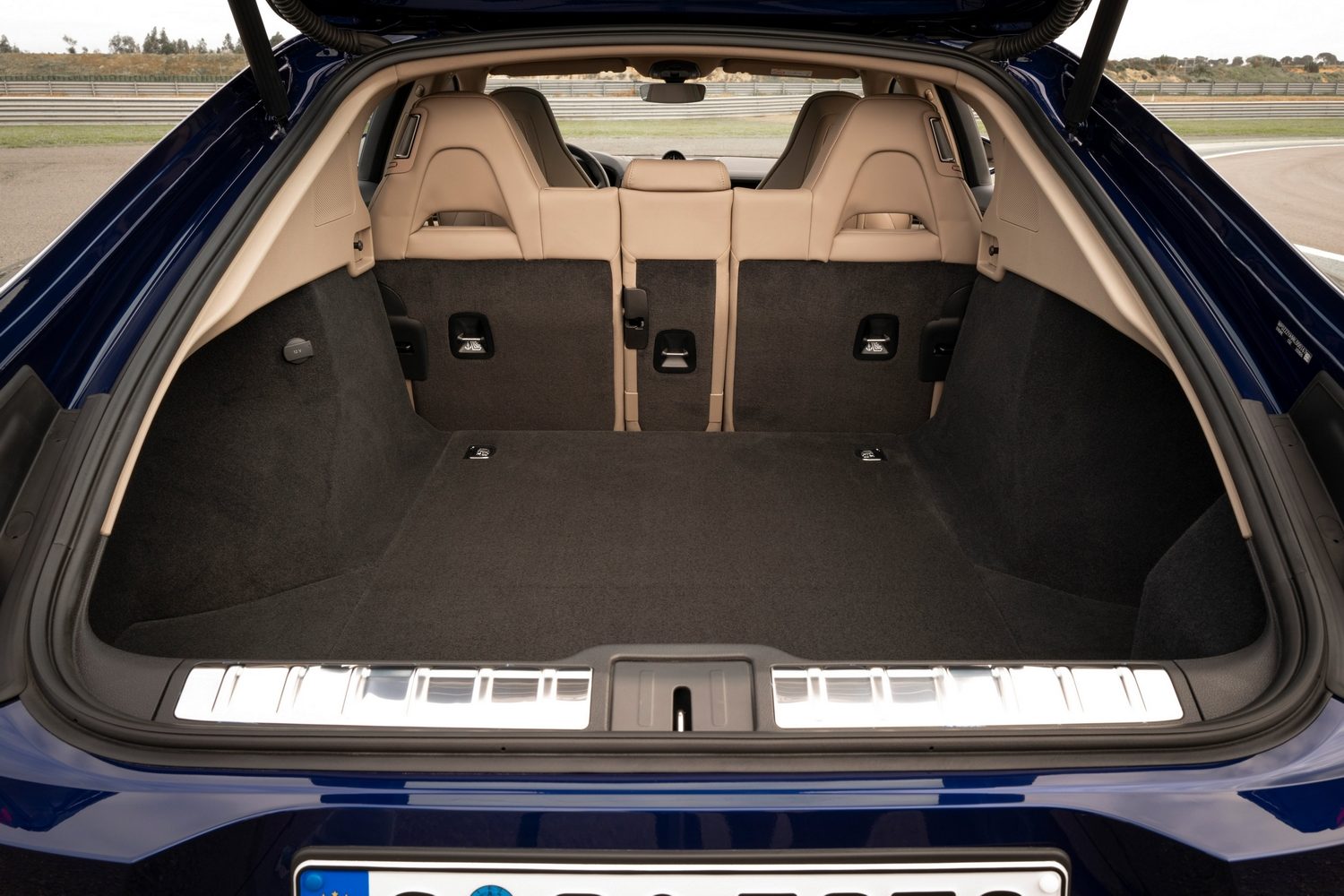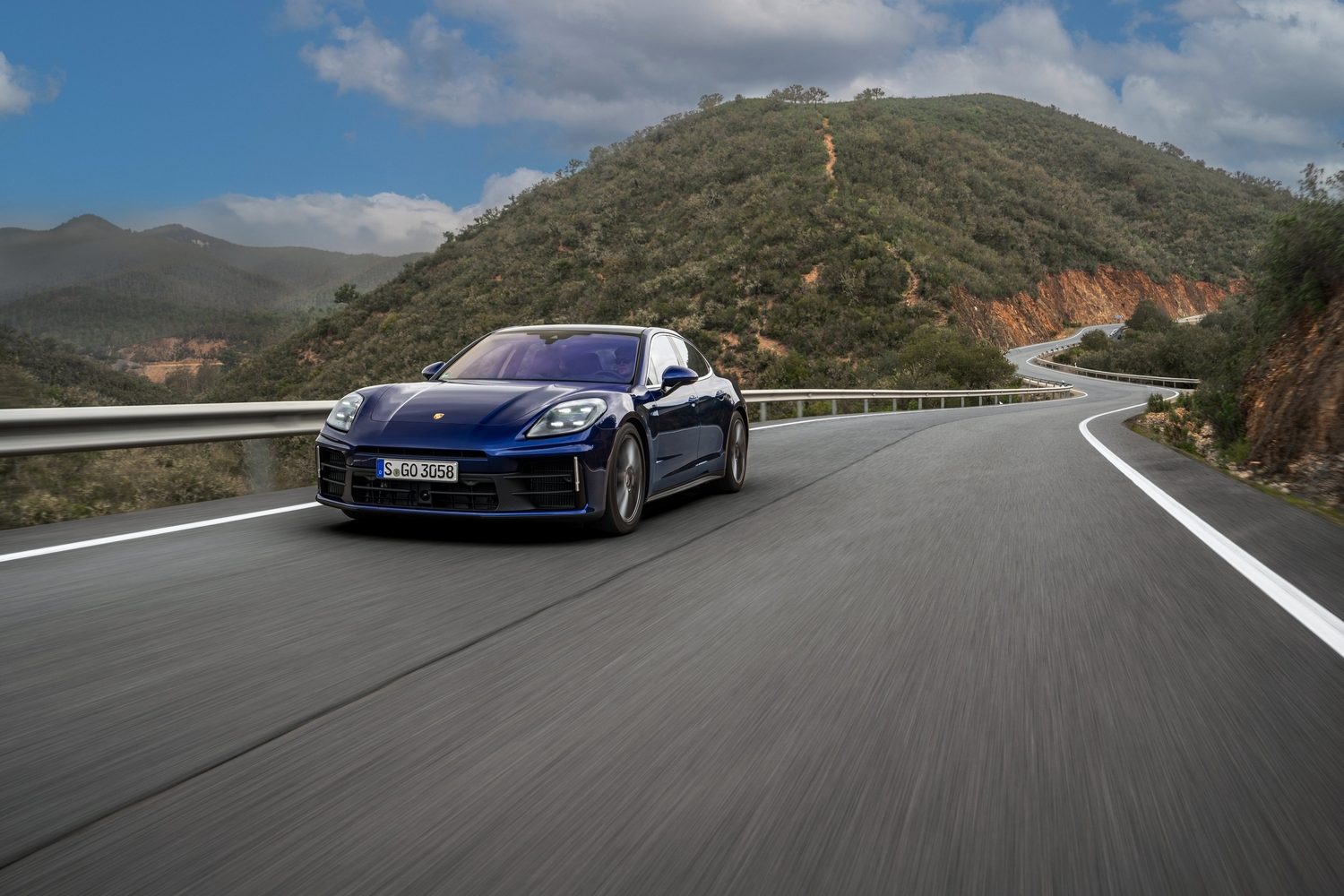Despite an ongoing shift to electric power and the presence of the Taycan zero-emission vehicle in its line-up, Porsche still feels there's a place for the Panamera executive car - so here's the third generation of the model. With a line-up heavily skewed towards plug-in hybrids under the German manufacturer's 'E-Hybrid' banner, can a pure-petrol model like the Panamera 4 still make sense in this ecological day and age?
In the metal
Visually, the new Panamera looks a lot like the car it replaces. But this is no bad thing, because - aside from the bloated original version - the Panamera has been a good-looking contrivance for some time now.
Still, even with familiarity for its shape in play, there are a few pointers that mark this out at the new one. For instance, the front air intake is a wider, square-shaped aperture, and it is teamed up to a horizontal 'slot' vent in the front bumper above the registration plate. Both the front wings have been raised a little too, giving them a more pronounced curve in profile and making them reminiscent of the same items on the Porsche 911 sports car; this also works well when you're sitting in the vehicle, as its wings are noticeable at the edge of your vision and they frame the road ahead.

Other than that, the same, clean flanks of the car and a rear denoted by a full-width light strip are traditional Panamera hallmarks nowadays, while a few of the hotter versions will also gain motorsport-inspired centre-lock alloy wheels. Not this Panamera 4, though, which has a more sensible five-stud fitment. Oh, and one last thing on the exterior: there will be no Sport Turismo estate this time around. It apparently represented less than ten per cent of global second-gen Panamera sales, so the company (sadly) feels there is no point bringing it back as a wagon for the Mk3; it's therefore a fastback only - one Porsche likes to refer to as a saloon.
Inside, the influence of the Taycan is obvious. Like the large Porsche Cayenne SUV, which recently received a similar dashboard layout during its midlife facelift, the latest Panamera has a 12.6-inch digital 'Curved Display' for an instrument cluster, with a central 10.9-inch Porsche Communication Management (PCM) infotainment touchscreen. Again, following on from the Taycan and Cayenne, there's also the option for a third large digital display if you opt for the 10.9-inch passenger display, which keeps the front-seat occupant who isn't driving entertained on longer journeys.
Further changes see the drive selector moving up to the fascia next to the steering wheel, but Porsche sensibly retains a separate, physical bank of switches for the climate controls. Overall, it's an ergonomically sound cabin with high material quality throughout, one or two strange foibles aside (press the heated seat button on that climate control area, for instance, and the whole panel moves, not just the bit for the seat), and the space in the back is magnificent too, thanks to the Panamera's long 2,950mm wheelbase.

That makes it practical, although it comes as a four-seater as standard. If you want a trio of three-point seatbelts in the back, you have to specify the '4+1' seating option but we really wouldn't bother if we were you, as the wide transmission tunnel in the car makes sitting in the central rear position look like it would be deeply uncomfortable, even for only a few minutes.
One other reason, apart from slow sales, for not bringing the Sport Turismo back this time is that it never had a much bigger boot than this standard model, and when you realise this Panamera 4 has a 494-litre cargo area with all seats in use, you can see why the estate is no longer necessary. Fold down the 40:20:40 split-folding rear seats and boot space rises to a 1,328 litres.

Driving it
As we said earlier, many of the new Panameras are E-Hybrids, using petrol engines and strong plug-in hybrid running gear for their drivetrains. Not only are they the most powerful versions, but they also take full advantage of our tax laws based on CO2 outputs and therefore are the best value-for-money models of the range in Ireland.
All of which leaves this car, the Panamera 4, in a strange hinterland. Aside from the monstrous 680hp Panamera Turbo E-Hybrid, it is the most expensive model out of the remaining four V6-powered machines, yet it's also the least potent. This is because it is powered solely by a 2.9-litre twin-turbo petrol engine, developing ample - albeit not jaw-dropping - outputs of 353hp and 500Nm.
You can have this basic V6 in either two-wheel-drive Panamera format, or with the added traction benefits of the Porsche Traction Management (PTM) all-wheel-drive system, which brings with it the little '4' suffix in the model badging. It's around €6,000 more than the rear-drive Panamera, adding 35kg to the kerb weight for a 1,995kg overall total.

This results in a slightly slower top speed on the Panamera 4, but quicker acceleration thanks to better off-the-line traction: it'll run 0-100km/h in five seconds dead as standard, or 4.8 seconds if fitted with the optional Sport Chrono package with launch control - those times are three-tenths quicker than the rear-wheel-drive model can manage, incidentally. However, it also brings increased fuel consumption and CO2 emissions which are all beyond 225g/km no matter which wheel size you fit, meaning the Panamera 4 will cost you €2,400 a year to tax; there's a chance, if you keep the two-wheel-drive version on its smaller 19-inch standard wheels, that you could creep into a lower band for €1,250 per annum.
All of which might look like we have a downer on the Panamera 4, but we can assure you that we don't. As top-end sports saloons go, it's one of the finest out there. Adaptive air springs with the fancy new two-valve Porsche Active Suspension Management (PASM) dampers is the standard chassis set-up and it brings with it a remarkable degree of control and comfort in almost all circumstances. True, you don't really want to dial the Panamera 4 up into Sport Plus on the road, as then the PASM is a bit too firm and has sharp vertical responses to the body when it hits large bumps in the road, but in all other settings it rides beautifully and manages to keep taut control of its two-tonne shell.
You won't lament the performance, either. While the Panamera 4 isn't scary quick, anything which can tick off 0-100km/h in less than five seconds still remains a rapid machine in this day and age, and you feel this most obviously when overtaking on two-lane, out-of-town roads. The Porsche will enact these manoeuvres with little fuss, sending its power and torque to all four wheels through a beautifully slick-shifting PDK dual-clutch transmission. If it's fitted with a Sports exhaust, the 4 even sounds superb in both Sport and Sport Plus modes, its V6 engine emitting a hard-edged snarl that is beautifully amplified by the exhaust pipes.
If there are any criticisms of the car, other than the too-firm damping in Sport Plus mode, it's that really abysmal road surfaces can introduce an elevated level of tyre roar into the cabin at faster speeds. It's quite substantial, regrettably, and is possibly more noticeable because there's an almost complete dearth of wind noise from the Panamera's slippery shape.

However, the road noise is only applicable on the worst asphalt, as most of the time the Panamera is assuredly comfortable and quiet to cruise in. Yet the star of the show isn't its refinement or its grip or its body control or its speed. It's the steering. Honestly, there are dedicated sports cars that are crying out to have steering like this Porsche executive car. Direct, perfectly weighted through all three modes, consistent, informative and controlled by one of the most perfectly sized and shaped steering wheels in all of the automotive world, simply turning the Panamera into corners and revelling at the crystal clarity of its feedback is a true delight. None of its obvious rivals can get anywhere close to it on this score.
What you get for your money
The problem for the Panamera 4, specifically, is its price. At €161,292, it is a victim of its high CO2 emissions here in Ireland (230-253g/km, depending on wheel size). Only the Turbo E-Hybrid eclipses it at €180,751, but that car has a monster 680hp V8 plug-in hybrid powertrain that turns the Panamera into a seriously high-performance machine, so the price gap is both understandable and in no way insurmountable.
Also, the Panamera 4 is more than €30,000 dearer than the 544hp 4S E-Hybrid, which uses its same V6 engine with a large slug of plug-in electrical assistance, or a whopping €45,530 more expensive than the 470hp 4 E-Hybrid that represents the entry point to Panamera ownership here (from a price perspective, at least).

The standard equipment list is reasonably good on the Panamera 4, by way of some mitigation - gone are the days when Porsche was notoriously stingy with its included kit - but there remains a lengthy list of chunkily priced options which could easily push the Panamera 4's purchase price to Turbo E-Hybrid levels and beyond if you're not careful.
And don't go thinking the same thing would apply to the 4S E-Hybrid, for example: even though it's a lot cheaper here, that's to do with our tax laws, not Porsche's view of its position in the line-up. So, the 4S E-Hybrid sits two rungs up the hierarchical ladder in the company's eyes and as such gets as standard much of the desirable equipment that would be an expensive cost option on the Panamera 4, further widening the value gap between these two models.
Summary
The new Porsche Panamera is a gentle - but most worthwhile - evolution of what went before. This means that you're left with one of the greatest sporty executive cars out there, one which can do luxurious and comfortable driving almost as well as it can do all the sort of road-holding tricks that make any self-respecting Porsche a 'proper' Porsche. The Panamera 4's issue here in Ireland is that it is relatively too expensive in its own line-up for what it is, both in terms of purchase and running costs, so there are better options elsewhere in the range. But if you do end up with this four-wheel-drive V6 model because you can afford it, you'll be utterly enraptured by the vehicle you end up with - as it's utterly brilliant.
















